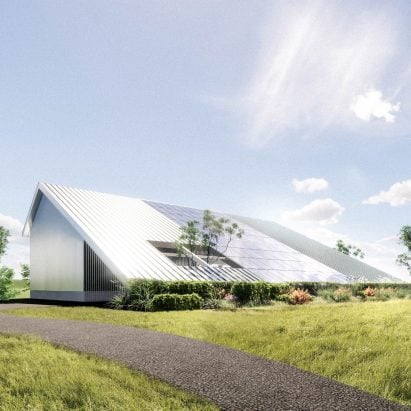Architecture studios such as SO-IL and Studio Jahn/ will collaborate with artists including Torwase Dyson and Alice Aycock to design 18 pavilions as galleries for Art Omi in Chatham, USA.
Called Art Omi Pavilions at Chatham (AOP), the project will incorporate 18 pavilions placed to house art and amenity spaces for the compound. Each pavilion will be designed in collaboration between an artist or collector and an architect of their choosing.
Art Omi Pavilions at Chatham will contain pavilions co-designed by artists and collectors to host their bodies of work. Pictured is a rendering of the Aycock Pavilion
The AOP campus will be placed in a wooded, rural area with an overall landscape design orchestrated by Brooklyn-based Assemblage Landscape Architects.
It will be completed in multiple phases, and at the end there will be 16 pavilions of roughly similar size. These will stand alongside the Biennial Exhibition Pavilion, which will be designed by Skolnick Architecture + Design for rotating exhibitions, and a series of interconnected “mini pavilions” for “extended viewing experiences” designed by Brooklyn-based SO-IL.
It will include 18 structures spread over a piece of rural land. Pictured is the visitor centre by BKSK Architecture
Each artist will work on the design with an architect they’ve chosen from personal experience, or through the reference of an advisory board.
“Each design is a collaboration between the artist or collector and the architect. Each building will be determined by the program and esthetic defined by this collaboration,” AOP founder Francis Greenberger told Dezeen.
“However, the ‘mini pavilion’ preliminary design represents a collaboration between the pavilion design committee and SO-IL architects as the building will serve multiple artists.”
The first phase of the design will have four structures, including a visitors centre with a cantilevered timber roof by New York City-based studio BKSK Architecture.
Among the pavilion collaborations for phase one will be a metal-and-solar-panel clad building with a slopped roof featuring apertures for trees to grow by American artist Alice Aycock and Chicago-based Studio Jahn/.
The pavilions are designed to be ideal viewing places for each artist or collection. Pictured is the Tadaaki Kuwayama + Rakuko Naito Pavilion
Japanese artists Tadaaki Kuwayama and Rakuko Naito have worked with Toronto studio Unit A Architecture to design a modernist, metal-clad form with an inset, clad-glad seating area.
The final structure for phase one will be a relatively simple structure with corrugated metal facing punctuated by voids exposing wooden beams designed between collectors Susan and Michael Hort and BKSK Architecture.
Only two structures have been announced for the second phase, a sculptural pavilion for American artist Torkwase Dyson designed by Manhattan studio Gluckman Tang and a Lee Skolnick’s 3D-printed Biennial Pavilion.
Renderings of Skolnick’s project show a building with typical 3D-printed cemetious walls conforming to the contours of nearby hills.
Each artist or collector selected an architecture studio to collaborate with. Pictured is the Hort Pavilion
The artist pavilions will primarily show the work of the collaborating artist, while the one in collaboration with collectors will show multiple artists from the collections.
According to Greenberger, this model allows the artist’s work to be viewed in contexts of their own choosing, creating a more holistic experience for the viewer.
Construction on the first phase will begin in June 2024.
Recently, Dezeen produced a short video on the 2024 edition of the Serpentine Pavilion in London, designed by Korean architect Minsuk Cho.
Last year, Torkwase Dyson installed a sound-oriented pavilion made from black-painted wood in St Louis, Missouri, USA.
The post Architect-artist pairings to create permanent pavilions in Upstate New York appeared first on Dezeen.
